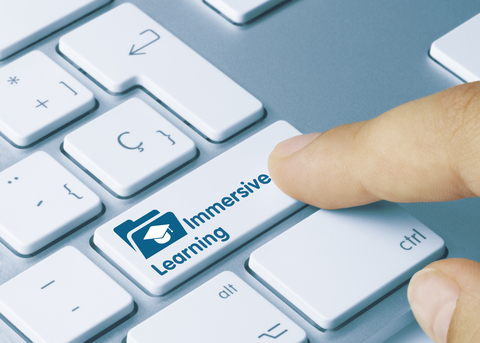
By Conor Gaffney, Ph.D.
Anyone who’s been given a pat on the back from a colleague knows the emotional response that results from being given positive feedback based on measured improvement.
With intelligent technology taking over learning & development (L&D) practices, that pat on the back comes in varied forms, such as the continued results and insights provided from immersive simulated learning technologies.
Employees also love taking immersive simulations – sometimes even repeating them after receiving a passing score since they want to improve on their performance.
Just like athletes practice and receive coaching to improve their performance in their chosen sport, a corporate learner can practice a new soft skill in the safe virtual environment of an immersive simulation. When they receive feedback on why a chosen answer is incorrect, the feedback is shared with the employee in a non-judgmental way that encourages improvement.
Triggering Emotional Connections
An immersive simulation focuses on skill-building through first-hand, experiential learning – whether it’s emotional intelligence, DE&I, communication skills or another key workplace soft skill.
Creating a customized workplace scenario that employees can relate to could include video content featuring their actual conference room, or actual company leaders. It can also mean details about a project the employee understands, having previously completed related work.
These realistic virtual workplace situations and environments, which subject matter experts and learning specialists create through an authoring tool, allow corporate learners to fully immerse themselves in the experience. Employees can identify with the characters and situations, which triggers an emotional connection to the simulation.
Studies show when peoples’ emotions are triggered during an activity, their motivation to complete the task at hand often increases. This emotional connection has an extra benefit in the case of corporate learning delivered through immersive simulations – the indirect effect that employees don’t mind when additional practice is needed, and they are also better able to retain the information being shared.
Immersive Simulations
It is now essential to develop skills-based, practice-oriented systems for learners with different skill levels and time availability through personalized learning paths and relevant content, while embracing different learning styles – which is possible with adaptive immersive simulations.
Training leaders love the data that they are able to use in determining next steps for their corporate learners – testing up, or testing out, of the immersive simulations. These automatically obtained metrics also enable seat-time savings – pre-assessment simulations can show which employees don’t need to take the sim. When they pass, employees can use their time on other tasks vs. spending time on unnecessary elearning, increasing productivity.
Given the virtual nature of the immersive simulation platform, and no need for extra hardware, it’s the type of scalable, elearning initiative that can be rolled out across multiple geographic locations to thousands of employees in multiple field offices.
A team still can take the same corporate learning simulation, even if its members are in different time zones and locations. They will still be able to relate to their peers, as they all go through the same scenarios and experience the same language and virtual workplace environments.
Making Connections
It’s clear that building connections with colleagues is key to ensuring a strong company culture, which in turn leads to business success. These connections can lead to skills transfer between senior workers and their more junior colleagues. Before 2020, in-person team-building exercises and other offsite meetings were a main method to bring employees together and create a fun, yet productive, environment.
With more remote and hybrid workers, there’s been a significant drop in social interactions, less team-building and fewer opportunities to build company culture. Upskilling hybrid teams is a challenge but can be achievable with the right strategies. It’s possible to get back to “business as normal” operational activities like meeting deadlines, securing revenue to boost bottom lines and retaining employees, especially with more resignations.
Conclusion
Corporate learning is playing a greater role within these success strategies. Now more than ever, L&D is being reimagined to combat worker departures, bring new hires up to speed and build back a malleable workplace culture based on agility and solidarity.
Delivering role-play experiences through an immersive simulation platform is effective, especially when face-to-face interaction is impractical or impossible. It can impact organizational culture in many areas, including onboarding; diversity, equity & inclusion; sexual harassment prevention; ethics; and leadership. The common thread is that these experiences are realistic and emotionally engaging.
The end result is effective and measurable employee upskilling and reskilling – and a good ROI.
What’s not to love about that?
Conor Gaffney, Ph.D., is chief product officer at ETU. Email Conor at








